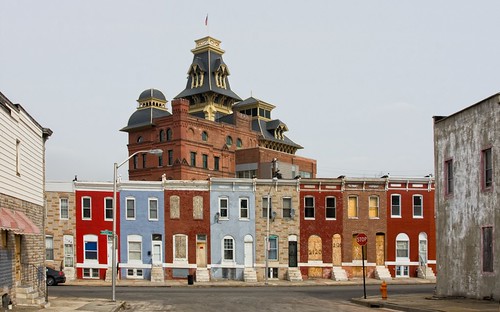 courtesy of flickr.com
courtesy of flickr.comThe Wiessner Brewery was a major employer for the city of Baltimore in the late 1800's. The brewery was located in the 1700 block of East Gay Street. It was founded and built by Brewmaster John Frederick Wiessner in 1863 by the community that is known as the Greenwood estate. This area seemed to be a popular area for breweries. Down the street of the Wiessner Brewery location, a brewery was built in 1853 by George Rost(The Standard Brewery) and another brewery was built around the same area by George Bauernschmidt in 1864.1
The Wiessner Brewery reached its highest peak of productivity in 1919. The brewery reached 110,000 barrels that year. They employed sixty one people; sixteen in brewery work, seventeen drivers, fourteen bottling house,eight garage men, and six office workers.2 It also helped that they had competition in its own neighborhood to vitalize the brewery and the neighborhood. "Those few blocks of Belle Air road(now Gay Street), must have been quite a site between 1886-1888 as both Wiessner and Bauernschmidt erected modern breweries, both said to be "show places of their day" ...The modern ice machines in these two plants were the first of their kind in Baltimore and created considerable interest and discussion".1
With the new building being built,The Wiessner brewery was not only known as a vital employer for the city but as a piece of art."The Flamboyant brewhouse, the complex 's overwhelmingly distinctive feature and an example of the Teutonic Brewery Style, fondly referred top locally as "Germanic Pagoda"...It has stained glass windows, three incredible towers and an altogether commanding silhouette". 6 1
Wiesnner's was an effective force in employing and vitalizing the neighborhood by bringing immigrants to the states. "Across the street is a three story townhouse surrounded by a brick and cast-iron fence, the residence of Wiessner and family. Its large size was strictly functional, for it housed not only the family but workers newly arrives from Germany'.3 Not only did he bring immigrants from Germany to work in the brewery, he brought in skilled professionals to the area. "They brought a brew-master, Dr. Eugene Schwoerer, graduate of Stuttgart and one of the finest brew-masters in Germany".4 This transition helped professionals move to Baltimore and help stabilize the neighborhood with potential homeowners.
In 1920, Wiessner Brewery closed its doors due to prohibition. The Wiessner property was sold to the American Malt Company in 1931. However, with the end of prohibition in 1933, the Wiessner brewery opened in production again as a brewery. The company name changed from the Wiessner Brewery to the American Brewing Company. 3
After prohibition ended, many people thought that beer making would revive the local economy and bring the promise of quality beer again to Baltimore."They say that the return of beer will put forty thousand folks to work in Baltimore...I can well believe it".4
The Allegheny Beverage Company was the last company to occupy the brewery. They were one of twenty one breweries in operation around Baltimore. Its production was 1000-1500 barrels per year or about .07%of the national production. 6 "American Beer" was produced here until 1973. In April 2009, the building, carefully rehabbed, opened its doors and became the Baltimore headquarters for Humanim. 5
View Larger Map(
courtesy of google earth)1. "The American Breweriana Journal", issue #103, March-April 2000, by
Art Distelrath.
2. "Brewed in Maryland" by William Kelley, 1965.
3. IBID
4. "News Reaches Brewery King That Horrific Dry Law may Be Quashed".
The Baltimore Post. September 9, 1932.
5. National Park Service. National Register of Historic Places.
December 8, 2009.
6. "Some Industrial Archeology of the Monumental City & Environs". Robert M Vogel.
1975.








